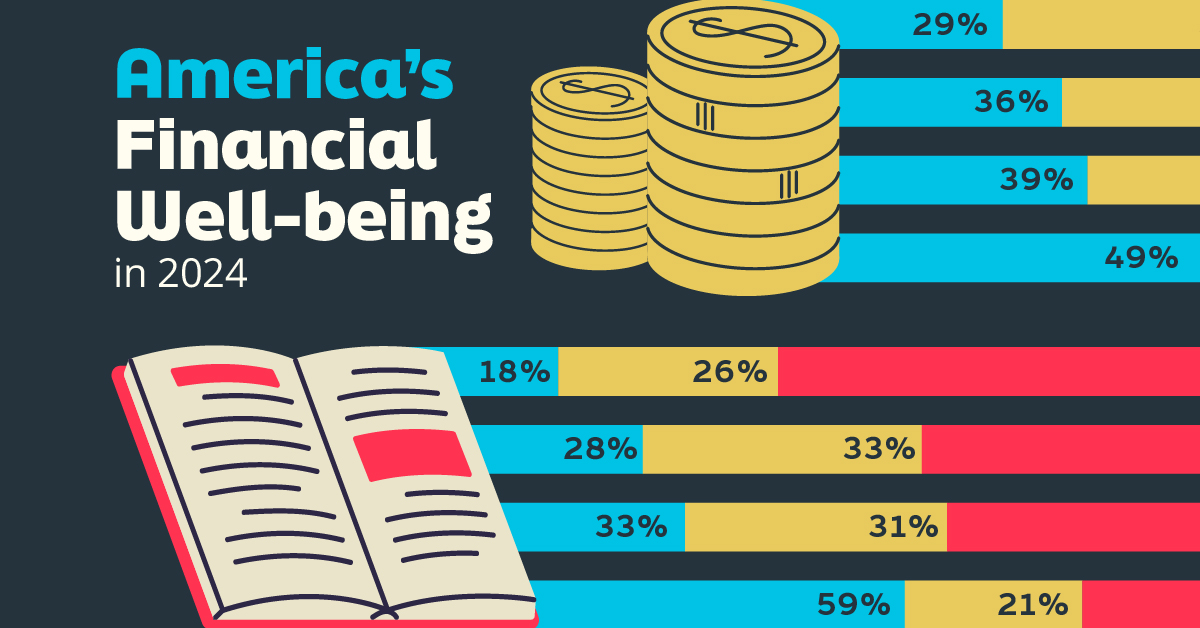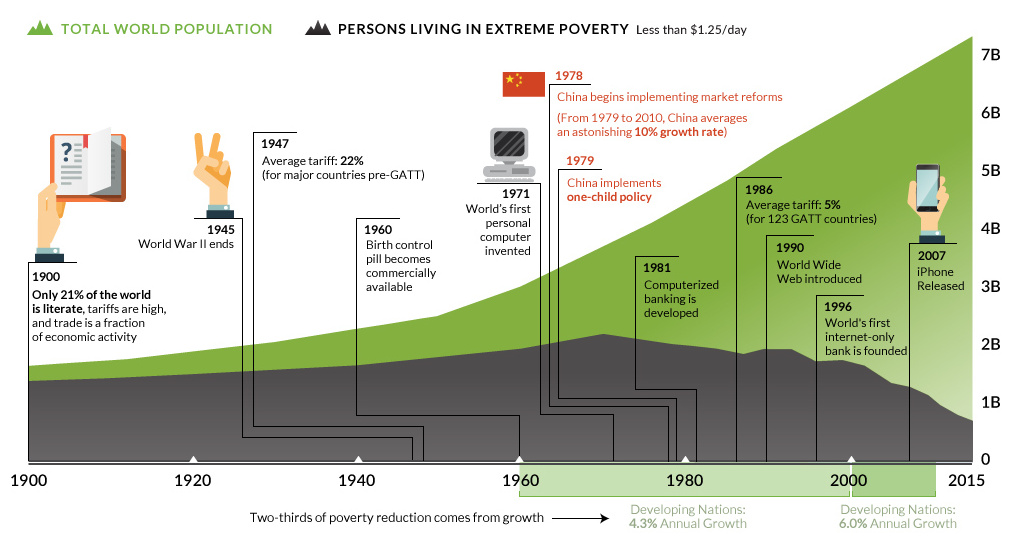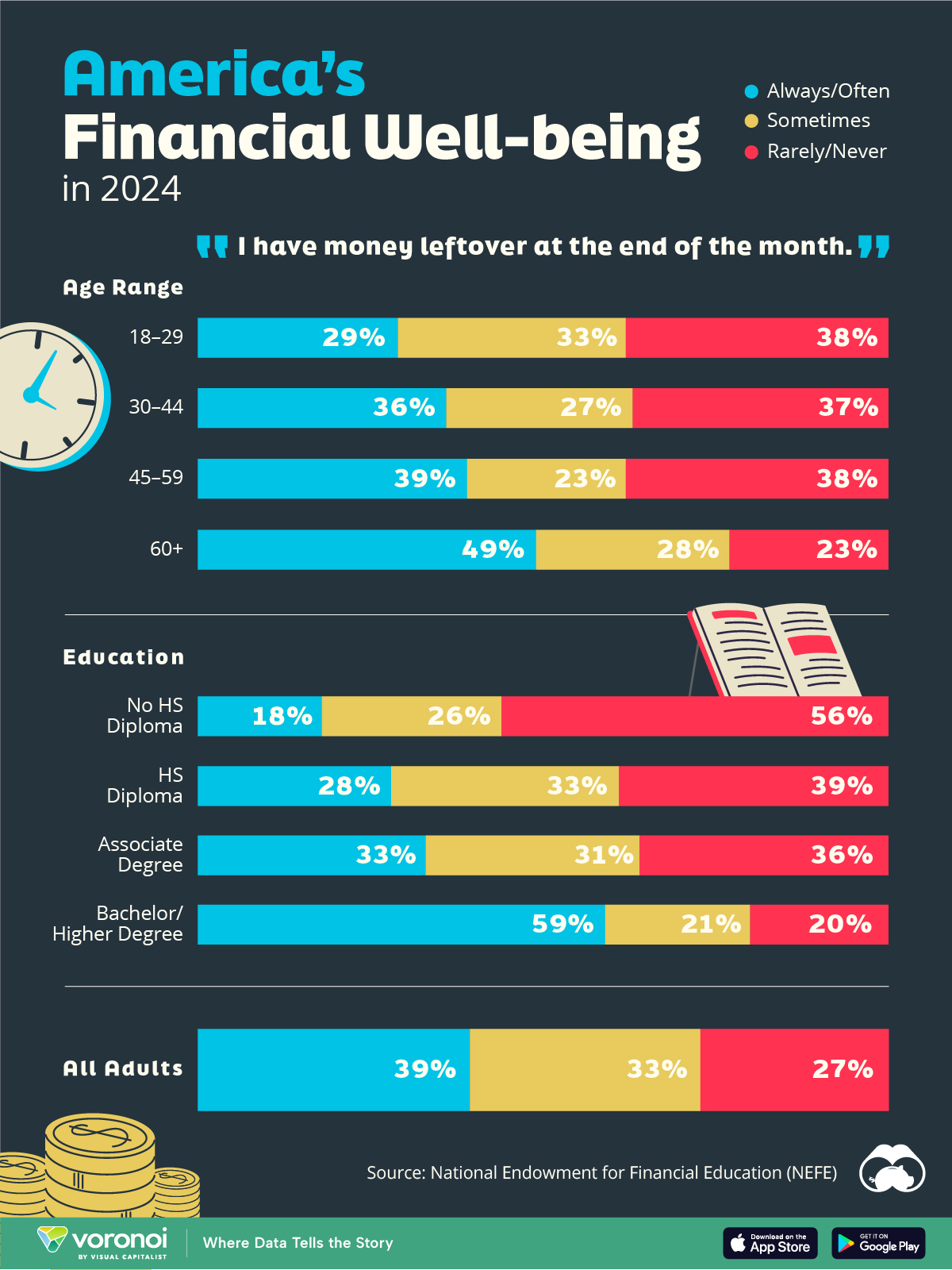Money
Visualizing the Poverty Rate of Each U.S. State
var divElement = document.getElementById(‘viz1543147079494’); var vizElement = divElement.getElementsByTagName(‘object’)[0]; if ( divElement.offsetWidth > 800 ) { vizElement.style.width=’1200px’;vizElement.style.height=’827px’;} else if ( divElement.offsetWidth > 500 ) { vizElement.style.width=’100%’;vizElement.style.height=’871px’;} else { vizElement.style.width=’100%’;vizElement.style.height=’1627px’;} var scriptElement = document.createElement(‘script’); scriptElement.src = ‘https://public.tableau.com/javascripts/api/viz_v1.js’; vizElement.parentNode.insertBefore(scriptElement, vizElement);
Visualizing the Poverty Rate of Each U.S. State
How many people live below the poverty line in states across the country?
Today’s interactive map comes to us from Overflow Solutions, and it visualizes the percentage of people living in poverty across the United States over the time period of 2008-2017.
U.S. Poverty Rates Today
To start, we’ll look at the situation using the most recent data, which was pulled from the American Community Survey (2017) done by the U.S. Census Bureau.
For additional context, it is worth noting that the national poverty level is estimated to sit at 13.4%.
Here are the five states with the highest levels of poverty today:
| Rank | State | Poverty Rate (2017) |
|---|---|---|
| #1 | Mississippi | 19.8% |
| #2 | Louisiana | 19.7% |
| #3 | New Mexico | 19.7% |
| #4 | West Virginia | 19.1% |
| #5 | Kentucky | 17.2% |
In three southern states, Mississippi, Louisiana, and New Mexico, nearly 20% of the population lives below the poverty line. Two Appalachian states round out the top five: West Virginia (19.1%) and Kentucky (17.2%).
On the flipside, here are the five states with the lowest levels of poverty:
| Rank | State | Poverty Rate (2017) |
|---|---|---|
| #47 | Connecticut | 9.6% |
| #48 (t) | Minnesota | 9.5% |
| #48 (t) | Hawaii | 9.5% |
| #50 | Maryland | 9.3% |
| #51 | New Hampshire | 7.7% |
New Hampshire (7.7%) has the lowest poverty rate by a long shot – about 1.6% lower than its closest competitor, which is the state of Maryland (9.3%).
Poverty Rates Over Time
While the data from 2017 provides an interesting snapshot, perhaps it is more insightful to look at the trend over time. In other words, are poverty rates increasing or decreasing?
Below is a comparison of state averages in 2008 (pre-crisis), 2012 (recent peak), and 2017:
| 2008 | 2012 | 2017 | |
|---|---|---|---|
| Avg. state poverty rate | 10.1% | 15.2% | 13.1% |
Since the recent peak in 2012, poverty has decreased by an average of 2.1% per state – in fact, over the 2012-2017 time period, there were only three states that did not see a reduction in poverty levels: Alaska, Delaware, and West Virginia.
Using the longer time window, however, you’ll see that poverty rates have actually risen by 3.0% on average since 2008. Today, not a single state has a lower poverty rate than it did in 2008.
State Poverty Rates (All)
Finally, here’s a full state table that is sortable and searchable, showing poverty levels in 2008, 2012, and 2017, for your convenience:
| 2008 | 2012 | 2017 | |
|---|---|---|---|
| Alabama | 13.1% | 19.0% | 16.9% |
| Alaska | 6.1% | 10.1% | 11.1% |
| Arizona | 12.6% | 18.7% | 14.9% |
| Arkansas | 14.6% | 19.8% | 16.4% |
| California | 11.2% | 17.0% | 13.3% |
| Colorado | 9.0% | 13.7% | 10.3% |
| Connecticut | 7.0% | 10.7% | 9.6% |
| Delaware | 7.6% | 12.0% | 13.6% |
| District of Columbia | 15.4% | 18.2% | 16.6% |
| Florida | 10.7% | 17.1% | 14.0% |
| Georgia | 12.4% | 19.2% | 14.9% |
| Hawaii | 5.8% | 11.6% | 9.5% |
| Idaho | 9.9% | 15.9% | 12.8% |
| Illinois | 10.0% | 14.7% | 12.6% |
| Indiana | 10.6% | 15.6% | 13.5% |
| Iowa | 7.9% | 12.7% | 10.7% |
| Kansas | 8.4% | 14.0% | 11.9% |
| Kentucky | 14.4% | 19.4% | 17.2% |
| Louisiana | 14.8% | 19.9% | 19.7% |
| Maine | 8.7% | 14.7% | 11.1% |
| Maryland | 5.7% | 10.3% | 9.3% |
| Massachusetts | 7.0% | 11.9% | 10.5% |
| Michigan | 11.5% | 17.4% | 14.2% |
| Minnesota | 6.5% | 11.4% | 9.5% |
| Mississippi | 19.0% | 24.2% | 19.8% |
| Missouri | 10.6% | 16.2% | 13.4% |
| Montana | 11.5% | 15.5% | 12.5% |
| Nebraska | 7.6% | 13.0% | 10.8% |
| Nevada | 9.0% | 16.4% | 13.0% |
| New Hampshire | 4.9% | 10.0% | 7.7% |
| New Jersey | 6.7% | 10.8% | 10.0% |
| New Mexico | 14.7% | 20.8% | 19.7% |
| New York | 11.1% | 15.9% | 14.1% |
| North Carolina | 12.0% | 18.0% | 14.7% |
| North Dakota | 8.6% | 11.2% | 10.3% |
| Ohio | 10.5% | 16.3% | 14.0% |
| Oklahoma | 13.2% | 17.2% | 15.8% |
| Oregon | 10.5% | 17.2% | 13.2% |
| Pennsylvania | 9.2% | 13.7% | 12.5% |
| Rhode Island | 8.3% | 13.7% | 11.6% |
| South Carolina | 13.0% | 18.3% | 15.4% |
| South Dakota | 9.7% | 13.4% | 13.0% |
| Tennessee | 12.9% | 17.9% | 15.0% |
| Texas | 14.1% | 17.9% | 14.7% |
| Utah | 6.9% | 12.8% | 9.7% |
| Vermont | 6.5% | 11.8% | 11.3% |
| Virginia | 7.9% | 11.7% | 10.6% |
| Washington | 8.4% | 13.5% | 11.0% |
| West Virginia | 13.1% | 17.8% | 19.1% |
| Wisconsin | 7.3% | 13.2% | 11.3% |
| Wyoming | 6.1% | 12.6% | 11.3% |
Money
Charted: Who Has Savings in This Economy?
Older, better-educated adults are winning the savings game, reveals a January survey by the National Opinion Research Center at the University of Chicago.

Who Has Savings in This Economy?
This was originally posted on our Voronoi app. Download the app for free on iOS or Android and discover incredible data-driven charts from a variety of trusted sources.
Two full years of inflation have taken their toll on American households. In 2023, the country’s collective credit card debt crossed $1 trillion for the first time. So who is managing to save money in the current economic environment?
We visualize the percentage of respondents to the statement “I have money leftover at the end of the month” categorized by age and education qualifications. Data is sourced from a National Endowment for Financial Education (NEFE) report, published last month.
The survey for NEFE was conducted from January 12-14, 2024, by the National Opinion Research Center at the University of Chicago. It involved 1,222 adults aged 18+ and aimed to be representative of the U.S. population.
Older Americans Save More Than Their Younger Counterparts
General trends from this dataset indicate that as respondents get older, a higher percentage of them are able to save.
| Age | Always/Often | Sometimes | Rarely/Never |
|---|---|---|---|
| 18–29 | 29% | 33% | 38% |
| 30–44 | 36% | 27% | 37% |
| 45–59 | 39% | 23% | 38% |
| Above 60 | 49% | 28% | 23% |
| All Adults | 39% | 33% | 27% |
Note: Percentages are rounded and may not sum to 100.
Perhaps not surprisingly, those aged 60+ are the age group with the highest percentage saying they have leftover money at the end of the month. This age group spent the most time making peak earnings in their careers, are more likely to have investments, and are more likely to have paid off major expenses like a mortgage or raising a family.
The Impact of Higher Education on Earnings and Savings
Based on this survey, higher education dramatically improves one’s ability to save. Shown in the table below, those with a bachelor’s degree or higher are three times more likely to have leftover money than those without a high school diploma.
| Education | Always/Often | Sometimes | Rarely/Never |
|---|---|---|---|
| No HS Diploma | 18% | 26% | 56% |
| HS Diploma | 28% | 33% | 39% |
| Associate Degree | 33% | 31% | 36% |
| Bachelor/Higher Degree | 59% | 21% | 20% |
| All Adults | 39% | 33% | 27% |
Note: Percentages are rounded and may not sum to 100.
As the Bureau of Labor Statistics notes, earnings improve with every level of education completed.
For example, those with a high school diploma made 25% more than those without in 2022. And as the qualifications increase, the effects keep stacking.
Meanwhile, a Federal Reserve study also found that those with more education tended to make financial decisions that contributed to building wealth, of which the first step is to save.
-

 Green1 week ago
Green1 week agoRanked: The Countries With the Most Air Pollution in 2023
-

 Automotive2 weeks ago
Automotive2 weeks agoAlmost Every EV Stock is Down After Q1 2024
-

 AI2 weeks ago
AI2 weeks agoThe Stock Performance of U.S. Chipmakers So Far in 2024
-

 Markets2 weeks ago
Markets2 weeks agoCharted: Big Four Market Share by S&P 500 Audits
-

 Real Estate2 weeks ago
Real Estate2 weeks agoRanked: The Most Valuable Housing Markets in America
-

 Money2 weeks ago
Money2 weeks agoWhich States Have the Highest Minimum Wage in America?
-

 AI2 weeks ago
AI2 weeks agoRanked: Semiconductor Companies by Industry Revenue Share
-

 Travel2 weeks ago
Travel2 weeks agoRanked: The World’s Top Flight Routes, by Revenue
















